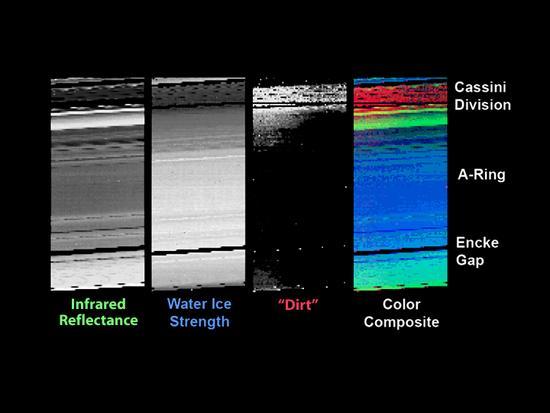‘Dirty Rotten’ Rings

| PIA Number | PIA06350 |
|---|---|
| Language |
|
'Dirty Rotten' Rings July 2, 2004 | |
The visual and infrared mapping spectrometer on the Cassini spacecraft has found evidence for a material dubbed "dirt" in Saturn's rings. The observations indicate that some type of sorting mechanism is concentrating this unidentified material in the gaps between the rings. | |
The water ice strength image shows the amount of water in the rings, which appears to peak in the region of the A ring.
The "dirt" image shows that the so-called dirty material is most abundant in the thinnest parts of the rings: the Cassini Division, in the Encke and in other small gaps. This material appears remarkably similar to what Cassini measured on Saturn's moon, Phoebe.
This color composite is a slightly smeared image in which multiple measurements of the same radial distance are repeatedly measured as indicated by the shallow diagonal banding. For example, the five red dots in the Encke Gap are repeated measurements of the inner edge of the gap.
The Cassini-Huygens mission is a cooperative project of NASA, the European Space Agency and the Italian Space Agency. The Jet Propulsion Laboratory, a division of the California Institute of Technology in Pasadena, manages the Cassini-Huygens mission for NASA's Office of Space Science, Washington, D.C. The Cassini orbiter was designed, developed and assembled at JPL. The visual and infrared mapping spectrometer team is based at the University of Arizona, Tucson, Ariz.
For more information about the Cassini-Huygens mission, visit http://saturn.jpl.nasa.gov . For more information about the visual and infrared mapping spectrometer visit http://wwwvims.lpl.arizona.edu.
Image Credit:
NASA/JPL/University of Arizona
